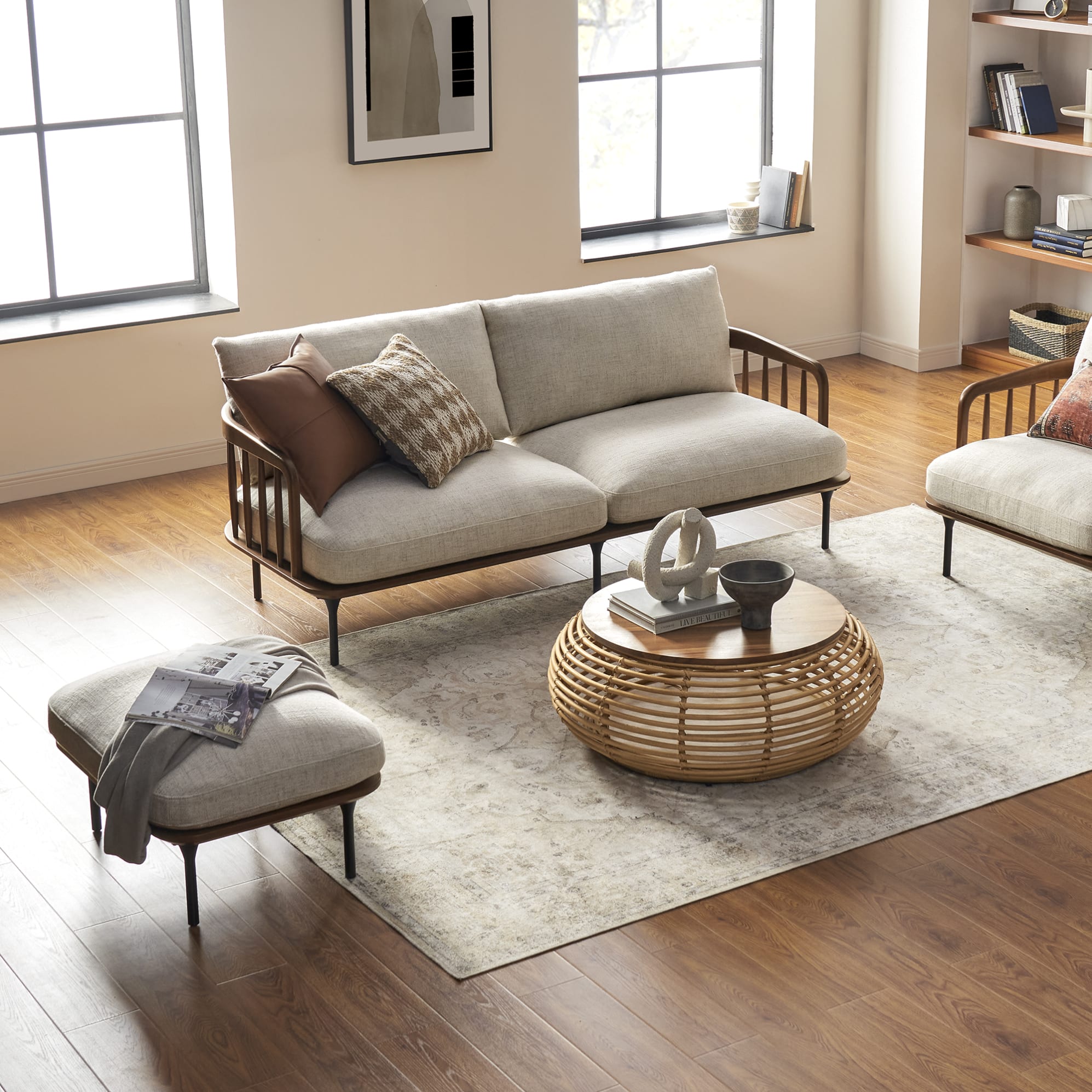
A Guide to Cleaning and Protecting Your Leather Sofa
A leather sofa is a timeless furniture piece that has made its way into the homes of many, infusing sophisticated charm into the space.
But, to maintain the leather’s allure and extend its lifespan, a little TLC is essential.
In this comprehensive guide, we'll walk you through the best practices and tips on how to clean and protect your cherished leather sofa. Whether you're dealing with spills, stains, or routine maintenance, our step-by-step instructions will ensure that your leather upholstery remains as good as new.
Understanding leather types and care
Not all leather is the same - different leather types and finishes can affect their care requirements. That’s why having a clear understanding of the type of leather you’re dealing with is a crucial step in cleaning and protecting your leather sofa.
Types of leather
Genuine leather
Genuine leather comes in different grades, with full-grain leather being the highest quality, followed by top-grain and split-grain leather.

The Madison Leather Sofa is upholstered in top-grain leather. Picture credits: @a.freckled.fawn.design
Full-grain leather retains the entire grain layer, showcasing the natural markings and imperfections of the hide, while top-grain leather undergoes slight processing to remove surface imperfections. Split-grain leather, on the other hand, undergoes more extensive processing to sand down imperfections and apply a surface finish.
Care for genuine leather involves regular cleaning and conditioning to maintain its suppleness and prevent drying out or cracking.
Recommended read: Full Grain or Top Grain Leather?
Bonded leather
Bonded leather is a mix of real and fake leather bonded together with adhesives and synthetic materials.
While it may contain some genuine leather particles, bonded leather is predominantly composed of synthetic materials like PU leather (Polyurethane Leather) or latex, making it more affordable than genuine leather.
Care for bonded leather involves gentle cleaning with a damp cloth and avoiding exposure to harsh chemicals or excessive moisture, which can cause the bonded layer to degrade.
Faux leather
Faux leather is typically composed of a fabric or plastic base coated with a layer of polyurethane or vinyl, giving it a leather-like appearance.
Faux leather is prized for its affordability, versatility, and ease of maintenance, making it a popular choice for budget-conscious consumers and vegan-friendly options.
Care for faux leather sofas involves regular cleaning with mild soap and water, followed by gentle drying to prevent water damage or discolouration.
Nubuck leather
Nubuck leather is a type of top-grain leather that has been sanded or buffed on the grain side to create a soft, velvety texture similar to suede.
However, it is more susceptible to stains and scratches and requires special attention and gentle cleaning methods to preserve its unique texture and appearance.
Nubuck-specific cleaners, protectors, and conditioners are recommended when cleaning nubuck leather to maintain its appearance and protect the delicate velvet-like finish.
Types of leather finishes
Aniline
Aniline leather is characterised by its natural, untreated appearance, showcasing the unique markings and imperfections of the hide. Leather that is dyed with an aniline finish is renowned for its softness, suppleness, and ability to develop a rich patina over time.
However, aniline leather is more susceptible to stains, scratches, and fading due to its lack of protective coatings.
Care for aniline leather involves gentle cleaning and regular conditioning to maintain its
Semi-aniline
Semi-aniline leather combines the natural beauty of aniline leather with the added protection of a light pigment layer. This pigment layer provides enhanced durability and resistance to stains, making semi-aniline leather a popular choice for furniture where both elegance and practicality.
Care for semi-aniline leather is similar to that of aniline leather, with a focus on gentle cleaning and conditioning.
Pigmented
Pigmented leather features a protective layer of pigment applied to the surface, creating a uniform colour and texture while providing enhanced durability and resistance to wear and tear.
This protective coating makes pigmented leather ideal for high-traffic areas and households with children or pets.

The Jonathan Leather Sofa features top grain leather with a pigmented finish. Picture credits: @tiffwang
Care for pigmented leather involves regular cleaning with mild soap and water, followed by the application of a leather conditioner to keep it supple and prevent drying out.
Recommended read: Aniline vs Semi-Aniline vs Pigmented Leather
Preparing for cleaning
Before you get down and dirty cleaning your leather sofa, it's crucial to prepare the area and gather the necessary tools and cleaning supplies. Here’s a checklist of items you'll need:
Mild leather cleaner
Microfibre cloth
Soft-bristled brush
Vacuum with a brush attachment
Leather conditioner (optional)
Dish soap or baking soda (for stain removal)
A step-by-step guide to cleaning a leather sofa
Step 1: Gentle dusting and vacuuming
Remove any cushions or accessories from the sofa to access all surfaces easily. With the vacuum and brush attachment, gently vacuum the entire surface of the sofa. Pay close attention to seams, crevices, and tufted areas where dust and debris may accumulate.
Step 2: Use a leather cleaner
With most dust and debris out of the way, you can now use a leather cleaner to help break down any tougher dirt and stains.
Apply an appropriate amount of leather cleaner onto a microfibre cloth and work it into the leather in circular motions.
Wipe down the sofa with a clean cloth to remove any remaining cleaner residue. Repeat as many times as needed to remove any stains.
Step 3: Hydrating and conditioning (optional)
Just as our skin craves moisture to maintain its suppleness, leather yearns for hydration to prevent drying and cracking.
Treat your sofa to a good leather conditioner, massaging it into the leather in a uniform manner. This not only restores moisture but also replenishes essential oils, revitalising the leather’s natural lustre.
How to spot-clean a leather sofa
Compared to fabric sofas, leather sofas are not as porous which means they don’t absorb liquid as quickly. But, it’s still important to address spills and stains promptly to prevent them from becoming permanent residents on your leather sofa’s surface.
Water-based stains like juice or sofa can leave behind visible discolouration marks on the leather surface, and ink stain can be particularly challenging to remove, especially if they've had time to set into the leather.
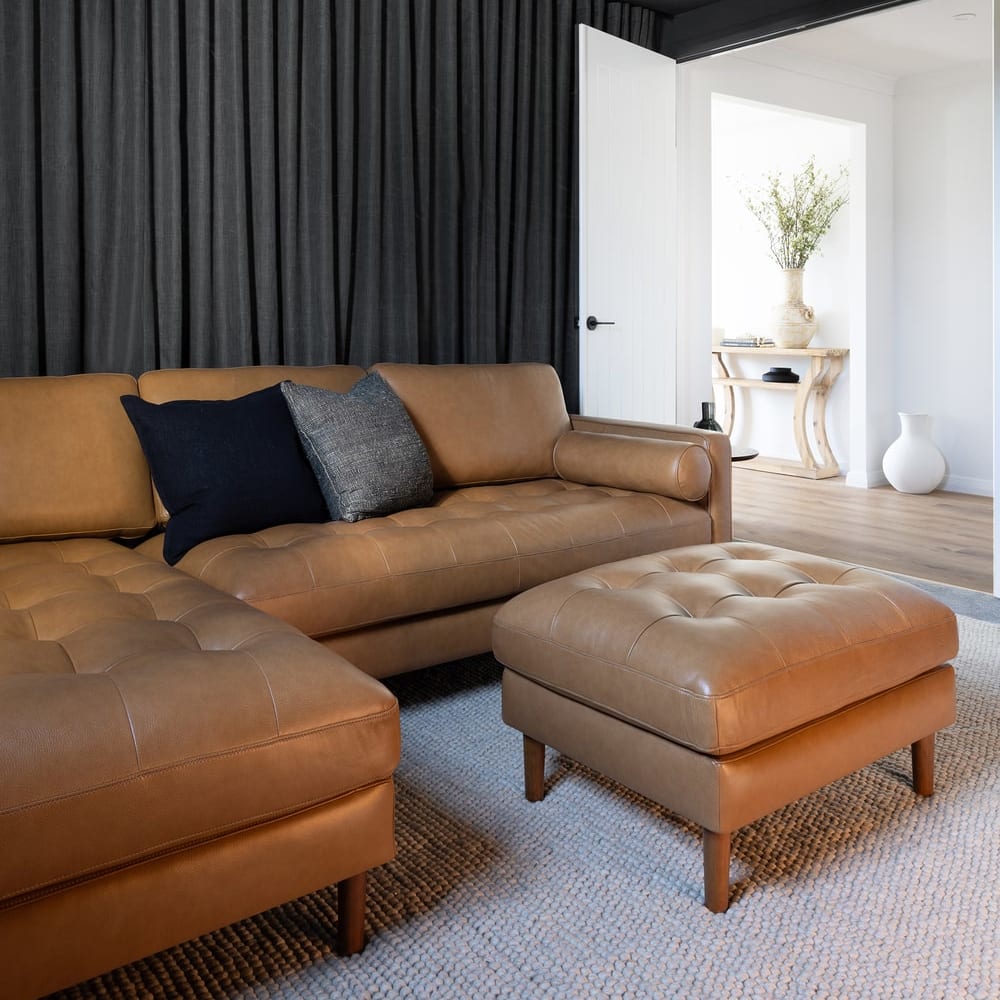
The Madison Leather Chaise Sectional Sofa with Ottoman. Picture credits: @oakandorange
To get rid of stains, use a mild soap solution (or specialised leather cleaner) applied to a damp soft cloth. Gently blot the stained area with the dampened cloth, working in gentle circular motions from the outside toward the center of the stain. This helps lift the stain without damaging the leather.
For stubborn stains, you may need to repeat this a few times to ensure it is removed or significantly reduced. Professional cleaning may be necessary for tougher stains.
Once the stain is removed, use a dry cloth to blot the area, removing excess moisture and allowing the spot to dry completely.
How to get mould off of a leather sofa
Mould on a leather sofa can be a serious issue, both aesthetically and for health reasons.
Before you begin the cleaning process, assess the severity of the mould infestation. If the mould covers a large area or has deeply penetrated the leather, it may be best to seek professional help to ensure thorough removal and prevent further damage.
Wear protective gloves, a mask, and eye protection to prevent contact with mould spores. Do work in a well-ventilated area to minimise exposure to airborne mould spores as well.
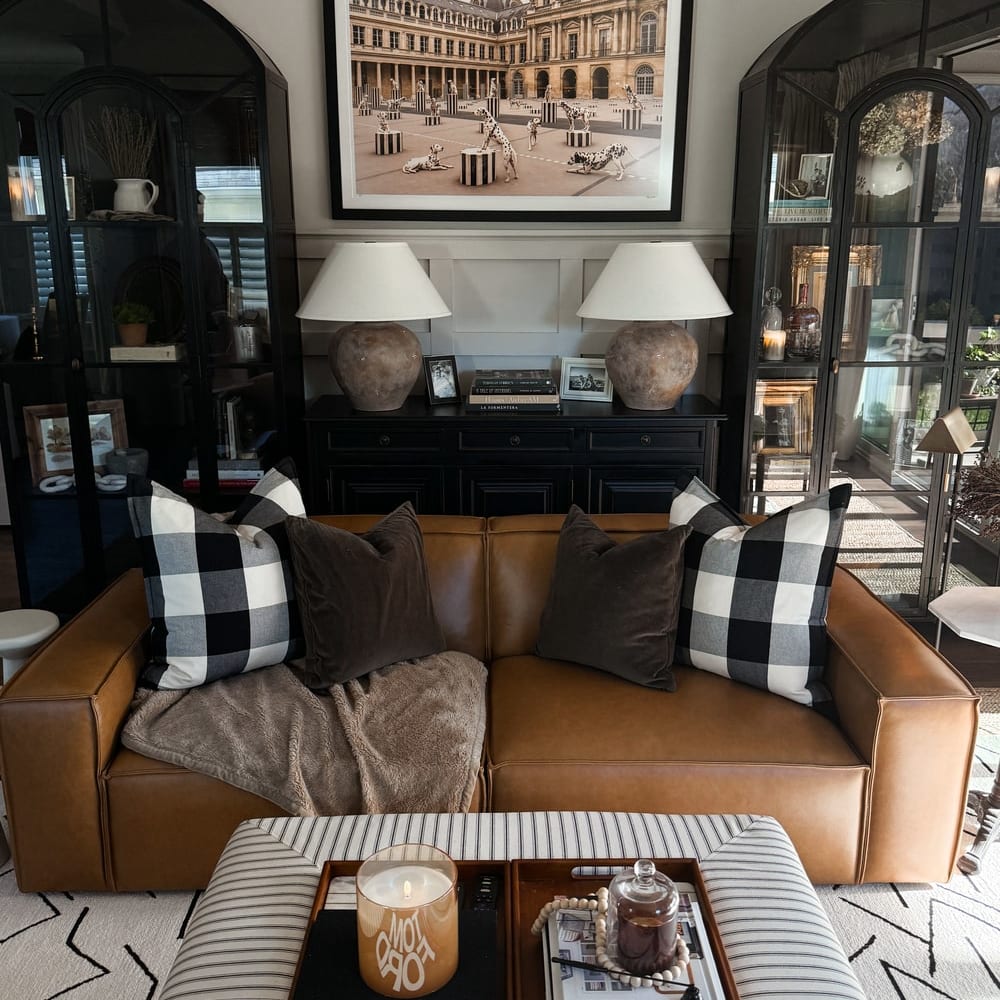
The Jonathan Leather Sofa and Lorenzo Wool Area Rug. Picture credits: @stayfoxx
Use a vacuum cleaner with a brush attachment to gently vacuum the surface of the sofa to remove any loose mould spores and surface debris. Use a solution of mild soap and water, or a specialised mould cleaner, and gently wipe the mouldy areas of the sofa with a damp cloth. Use circular motions to lift the mould from the surface and avoid scrubbing too vigorously, as this can damage the leather.
After cleaning the mouldy areas, use a dry cloth to blot the sofa to remove excess moisture. Allow the sofa to air dry completely in a well-ventilated area.
Recommended read: Mould on Furniture: Causes, Removal, and Prevention
Tips for long-term maintenance and protection of leather
Maintaining the allure of your leather sofa extends beyond the cleaning process - it requires a holistic approach to long-term care. After all, prevention is better than cure!
Avoid direct sunlight
Like a delicate flower, leather is susceptible to the harsh rays of the sun, which can cause fading and premature aging. Whether it’s genuine leather or faux leather, the sofa can benefit from being shielded from UV rays.
Position your sofa away from direct sunlight or use curtains and blinds to create a protective barrier, safeguarding its beauty.
Keep it away from heating elements
In addition to shielding your leather sofa from the harmful UV rays of the sun, it’s important to also keep it away from any heating source to prevent fading or discolouration. If you have a fireplace or radiator, be mindful of placing your sofa too near them.
Use protective covers
Consider using protective covers, especially if you have young children or pets. Throws, blankets, or slipcovers can act as a barrier against spills, stains, and scratches.
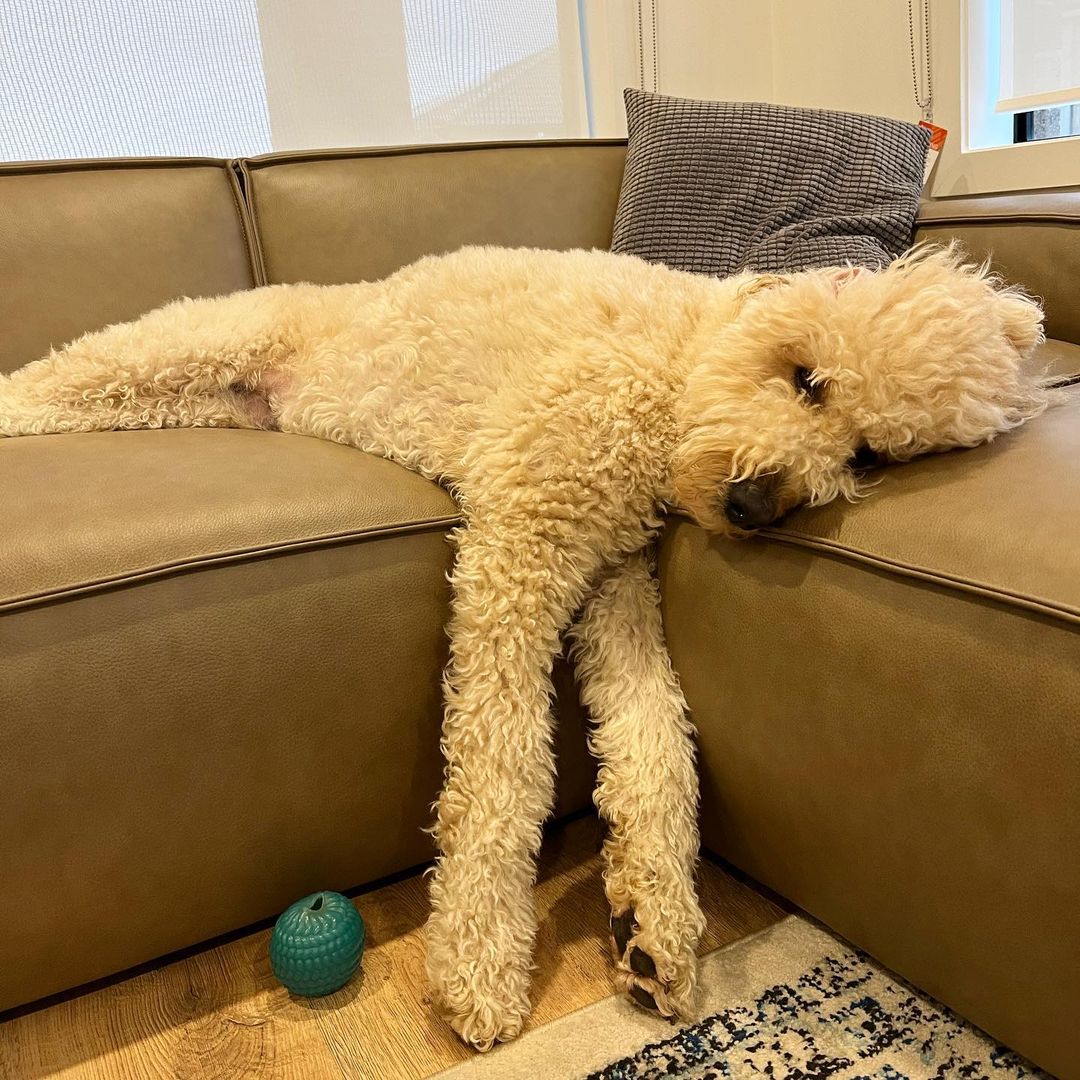
For households with pets like @baby._.bonui, throws and sofa covers can help protect your sofa. Pictured: The Jonathan Leather Sofa.
Take preventative measures for mould growth
To prevent mould from growing or returning, keep the sofa in a well-ventilated area with adequate airflow. Keeping your leather sofa in a damp environment can speed up mould growth.
Apply leather conditioner
Conditioning your leather sofa is an essential step to preserving its beauty, especially if it's a genuine leather sofa. Consider conditioning your leather sofa every 6 to 12 months to replenish moisture and prevent it from drying out.
Common leather cleaning mistakes to avoid
When cleaning and maintaining leather furniture, it's important to avoid common mistakes that can lead to damage. Here are some mistakes to steer clear of:
Using harsh chemicals
Abrasive cleaners and chemical-laden products like bleach or ammonia spell disaster for your leather sofa, stripping away its protective finish and leaving behind unsightly damage. Opt for gentle, pH-balanced cleaners specifically formulated for leather care to preserve its integrity.
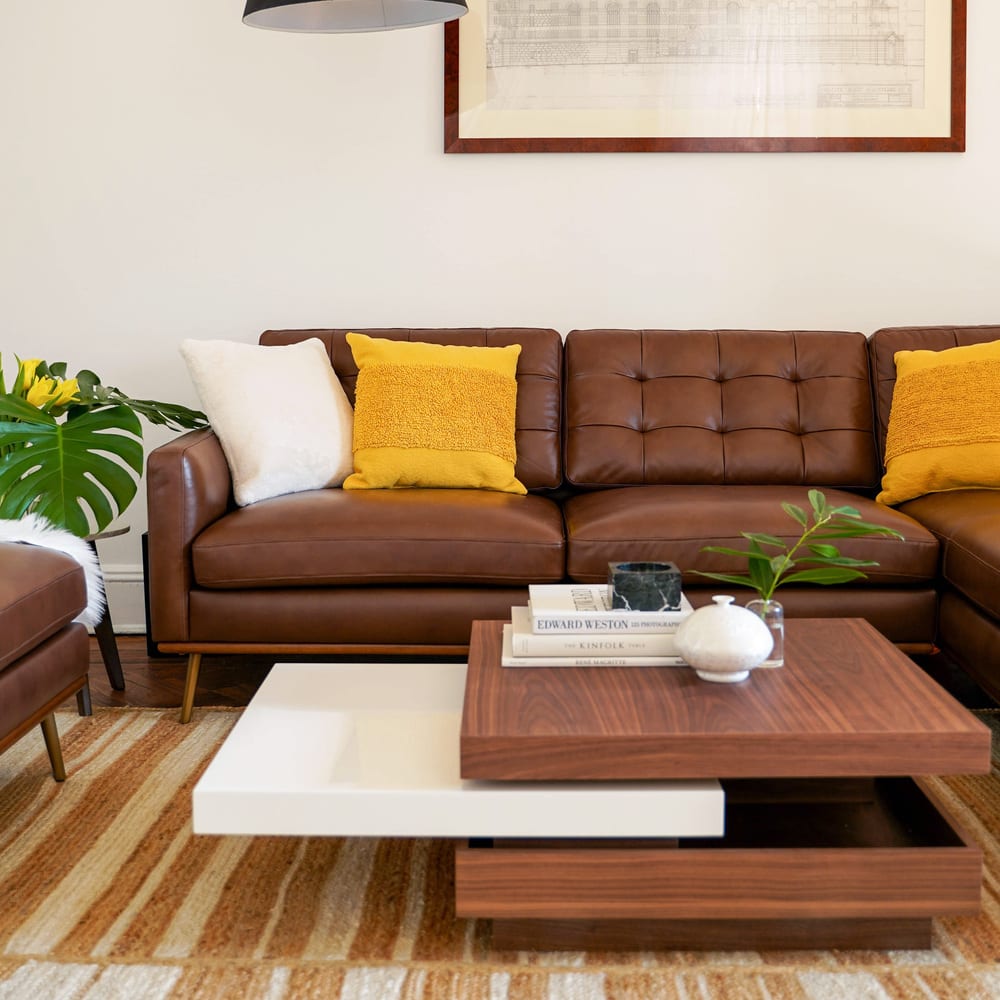
The Isaac Leather Terminal Chaise Sectional Sofa with Ottoman. Picture credits: @mensweardog
Using abrasive materials
Scrubbing leather with abrasive materials such as rough brushes or abrasive sponges can scratch or damage the surface. Stick to soft cloths, microfibre towels, or gentle brushes specifically designed for leather cleaning.
Excessive water usage
Overly wetting leather can lead to water stains or damage. Use a damp cloth or sponge when cleaning rather than soaking the leather. Ensure you dry the leather promptly after cleaning to prevent moisture absorption.
Ignoring the manufacturer's instructions
Each leather product may have specific care instructions provided by the manufacturer. It's important to read and follow these instructions carefully to avoid any potential damage or voiding of warranties.
Caring for your leather sofa is not just about maintaining its appearance but also preserving its timeless elegance and durability. With a little dedication, your leather sofa will continue to exude beauty, comfort, and sophistication for years to come.
FAQs
How often should I clean my leather sofa?
The frequency of cleaning your leather sofa depends on various factors such as usage, environmental conditions, and the specific needs of your sofa. But, it's advisable to perform routine maintenance such as gentle dusting and vacuuming weekly. This helps remove surface debris and dust, preventing them from settling into the leather and causing damage over time.
How do I clean grease or oil stains from my leather sofa?
For oil-based stains, using baking soda is a great way to remove the stains. Sprinkle some baking soda directly onto the oil stain. Baking soda is highly absorbent and can help draw out the oil from the leather. Dust off the baking soda after 15 to 20 minutes and clean the area with a mild soap solution.
How can I make my leather sofa look new?
Other than regular cleaning, applying leather conditioner and polish can help prolong its lifespan and keep it looking fresh and new for years to come. Additionally, be sure to protect your sofa from direct sunlight, excessive heat, and spills to prevent premature aging and maintain its pristine condition.
